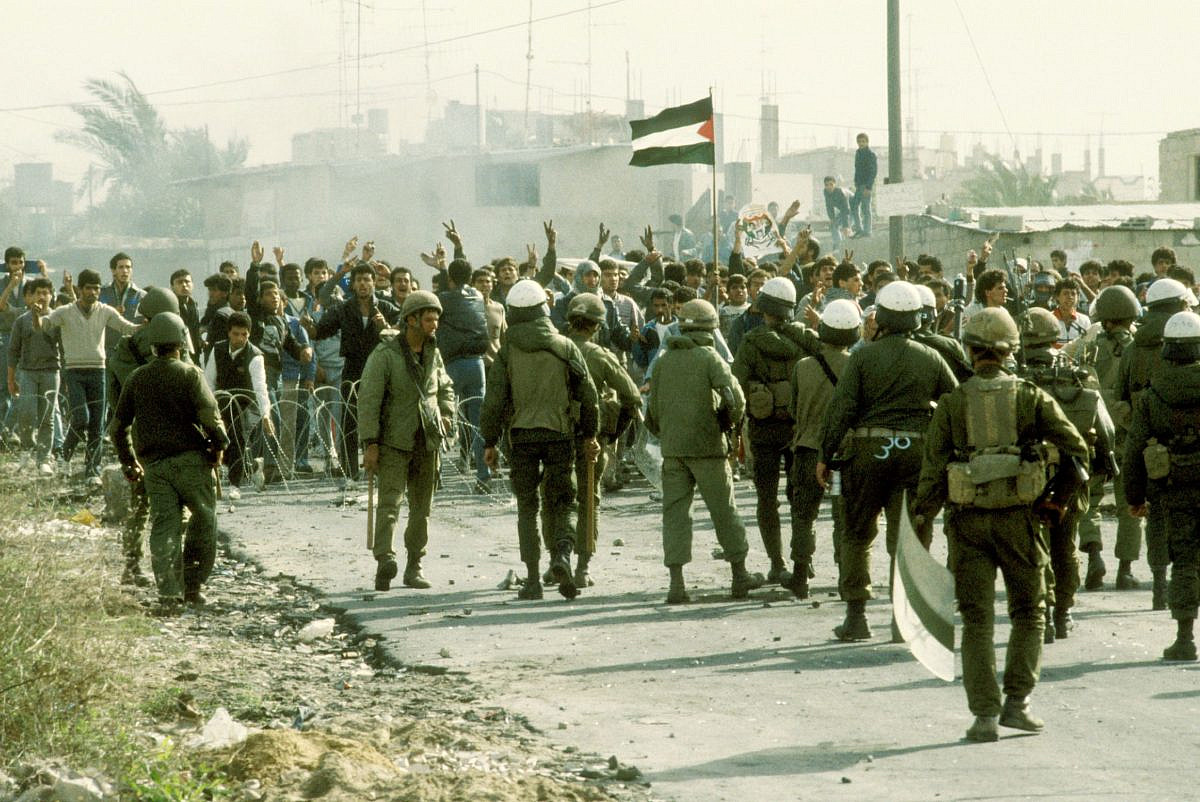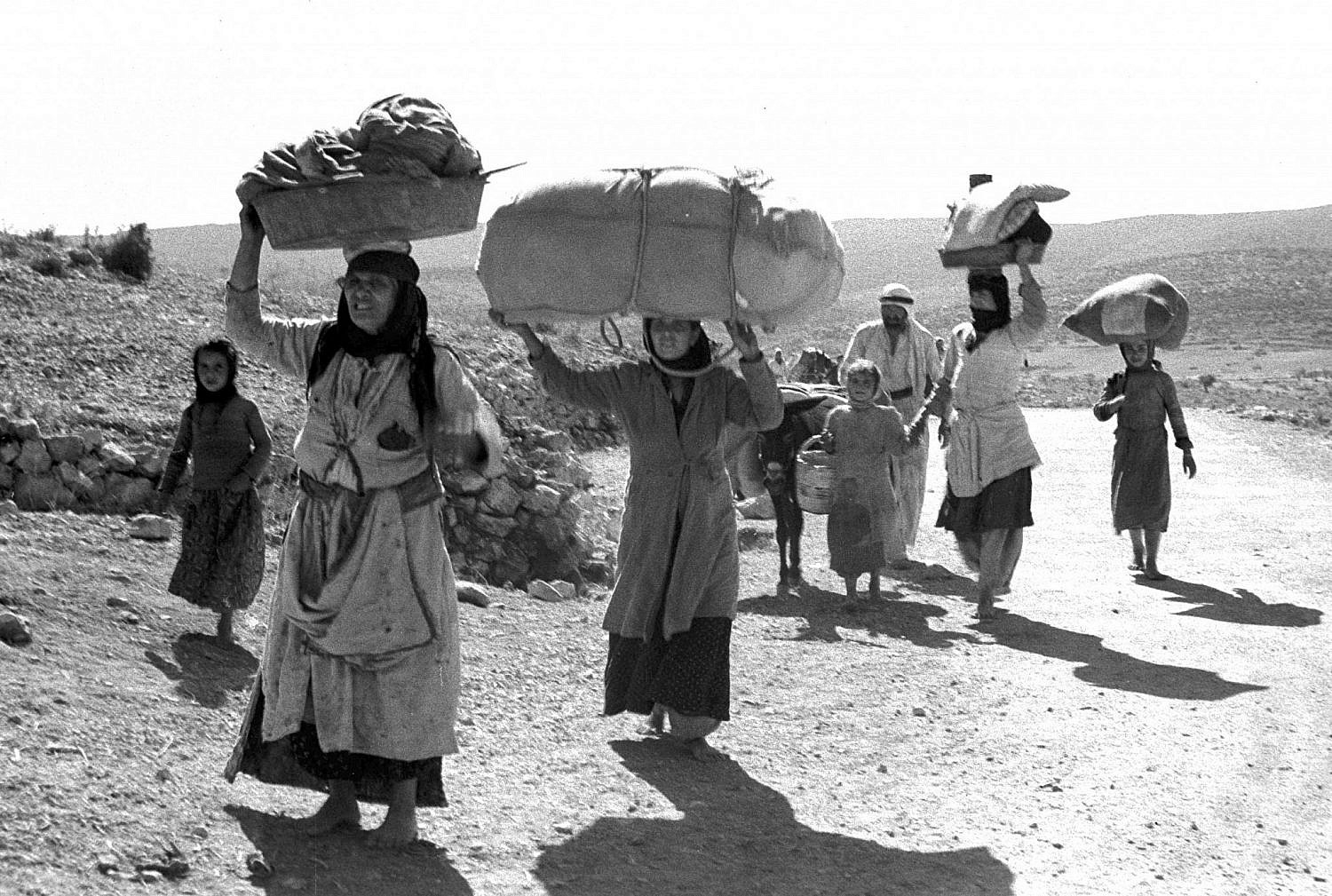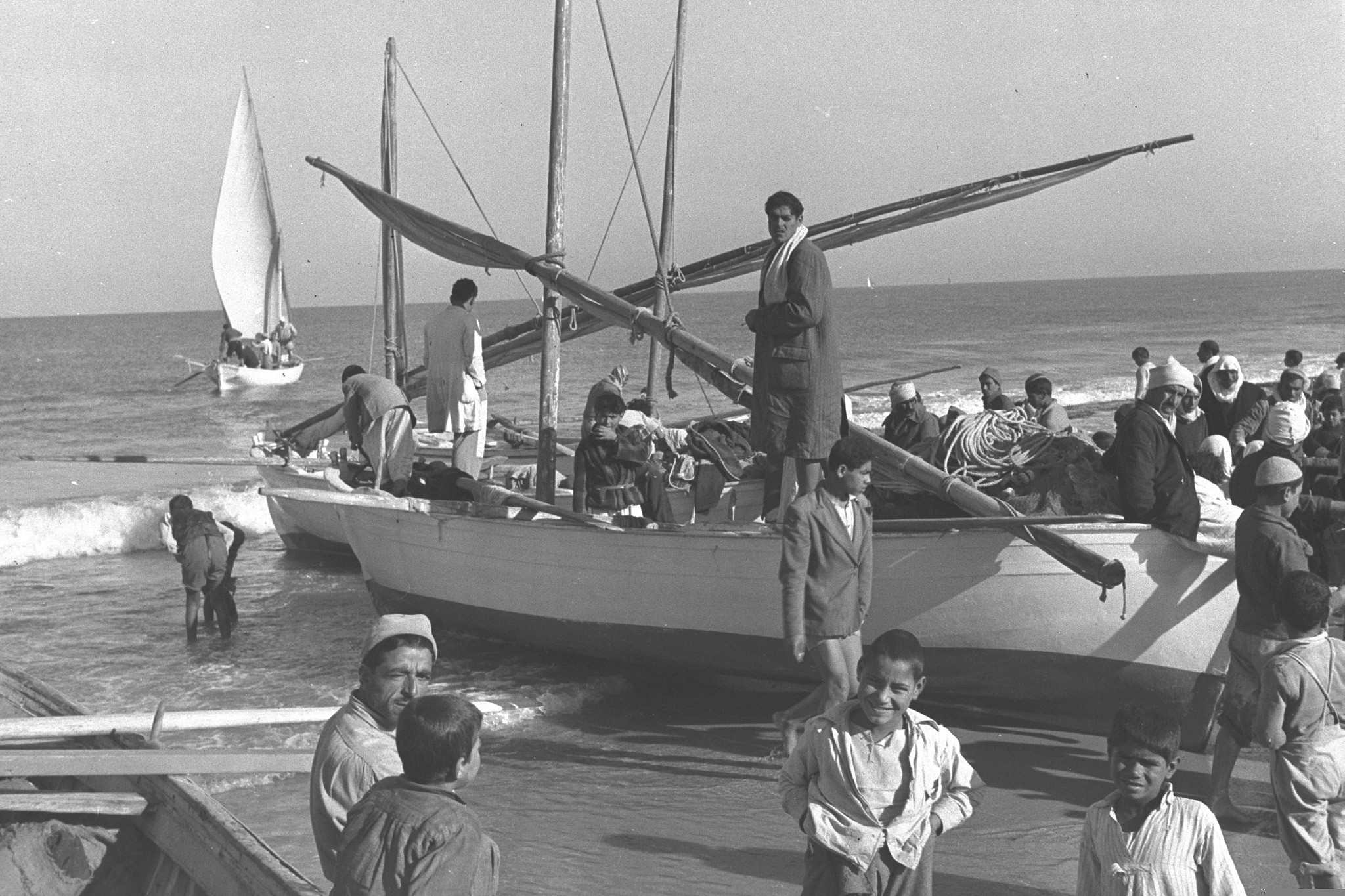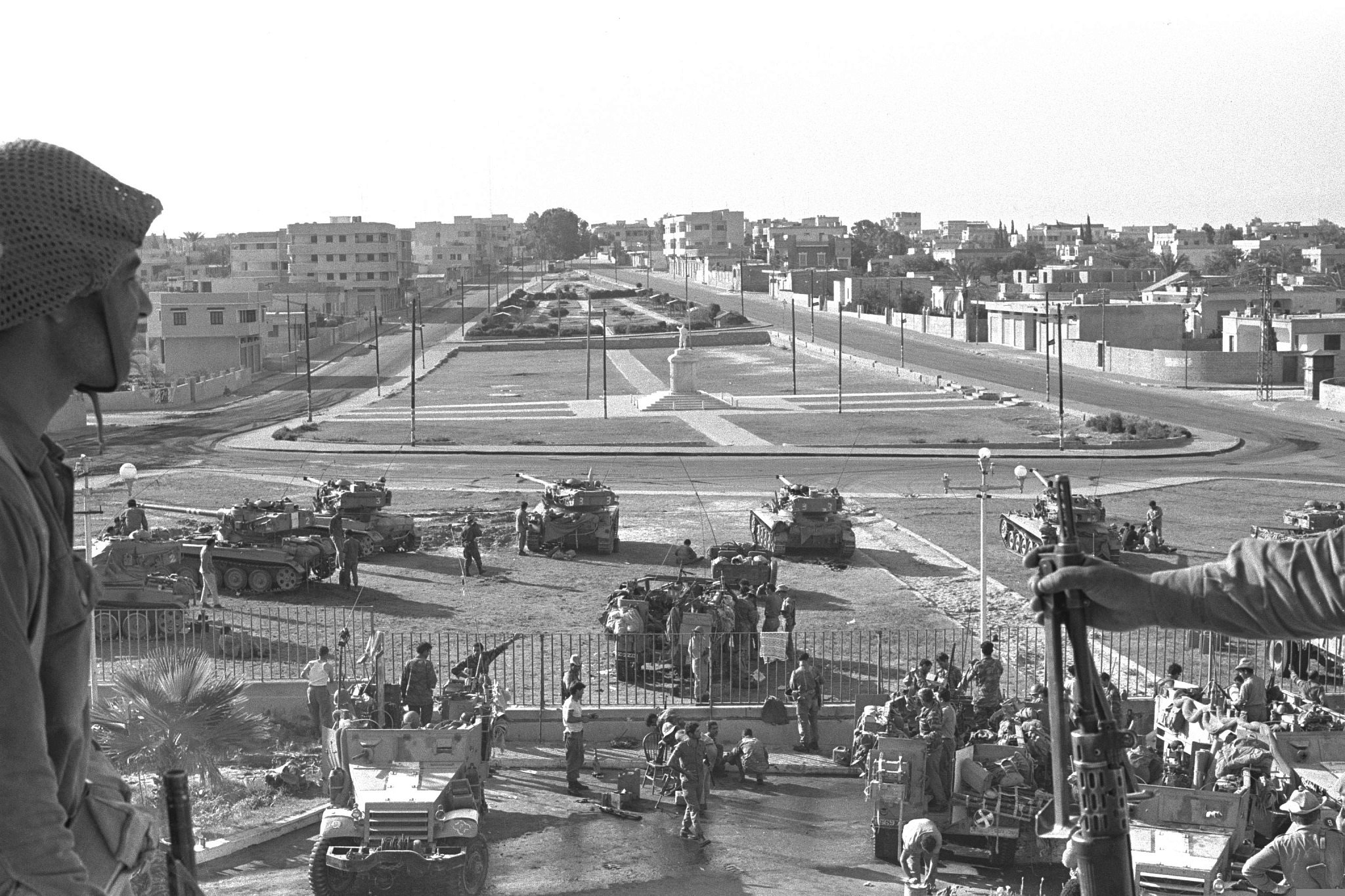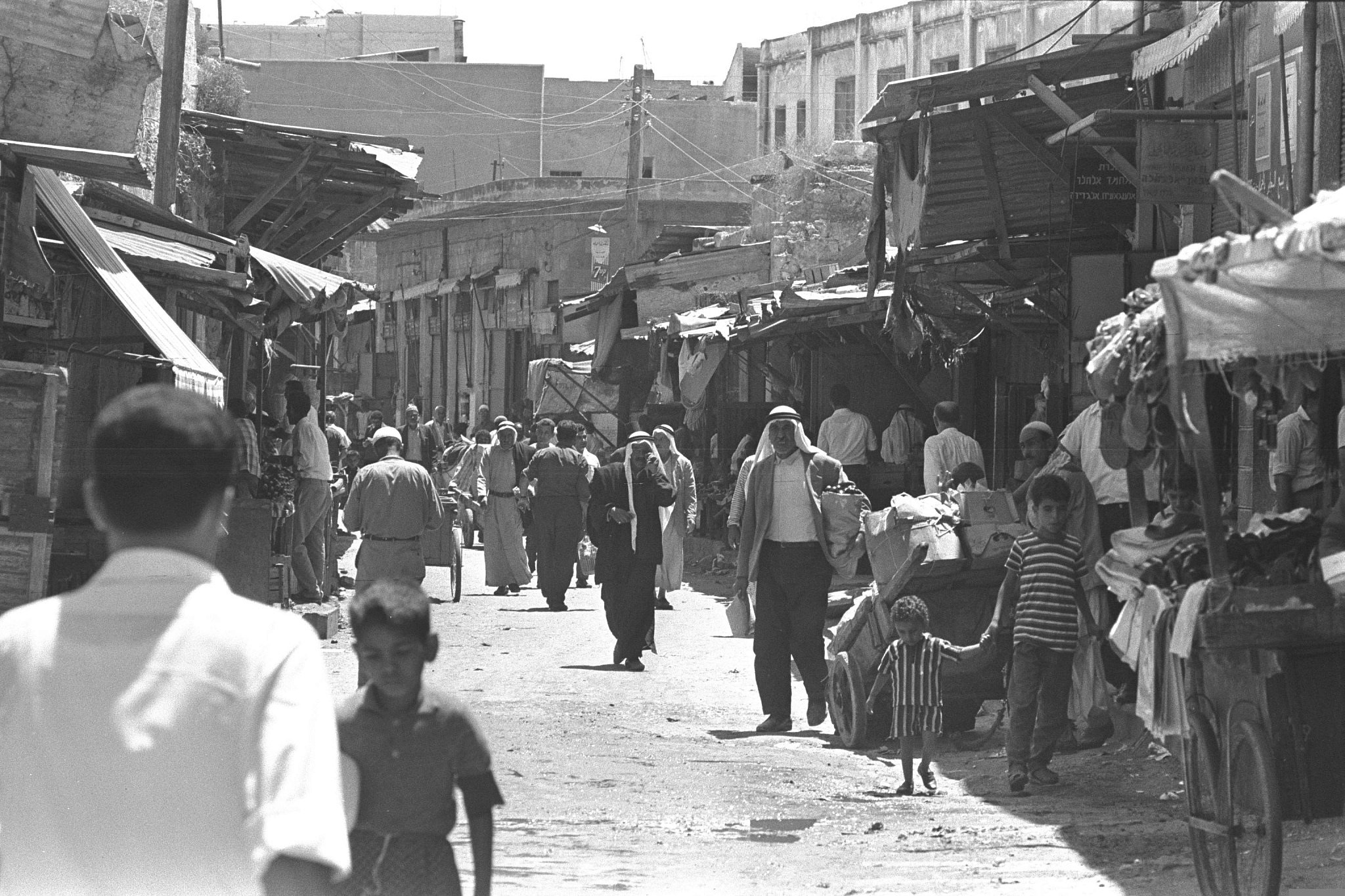More than half a century after beginning its occupation of the Gaza Strip, there are mounting signs that Israel is using its current military offensive to remake the territory completely.
On October 30, +972 published an official document from Israel’s Intelligence Ministry recommending the full-scale expulsion of all Palestinians from Gaza into the Sinai desert. After reports of the Israeli government lobbying for Egypt to accept large numbers of Gaza’s population, Prime Minister Benjamin Netanyahu confirmed in a Likud party meeting that he was actively seeking to “transfer” Palestinians out of the Strip. Calls for mass expulsion, which were on the rise on the Israeli right even before October 7, have become increasingly acceptable in mainstream Israeli discourse.
Attacks on Gaza’s infrastructure and civilian population appear to corroborate such plans. UNRWA Commissioner-General Philippe Lazzarini has stated that for the first time since its creation 74 years ago, the agency is unable to fulfill its mandate in Gaza. Some commentators are contending that Israel’s actions in Gaza now comprise domicide — the deliberate and mass destruction of homes in order to make an area uninhabitable.
The Palestinian death toll since October 7 has already exceeded the total numbers killed by all previous Israeli operations in the Strip this century. At the time of writing, Israeli forces have killed over 21,000 Palestinians in Gaza, 70 percent of whom are women and children; more than 51,000 people have been injured; and nearly 1.9 million, the vast majority of the Strip’s population, have been displaced.
While defending its actions in Gaza as necessary and denying accusations of war crimes, the Israeli government is describing its war in existential terms. Hamas’ raid on October 7 was one of the deadliest attacks on Israel in the state’s history. For the first time since 1948, Israeli forces temporarily lost control of territory within the Green Line, as Hamas killed more than 1,200 Israelis, injured more than 5,000, and kidnapped about 240 people, the majority of them civilians. The impact on the Israeli psyche, and the resulting collective trauma, has been profound.
Capitalizing on such feelings, the Israeli government, with the wide support of the public, has framed the attack on Gaza as a battle for survival. Defence Minister Yoav Gallant has said “it’s either them or us,” and described the air-and-ground assault as “a war for Israel’s existence as a prosperous Jewish state in the Middle East.” Netanyahu has dubbed it “the second war of independence.”
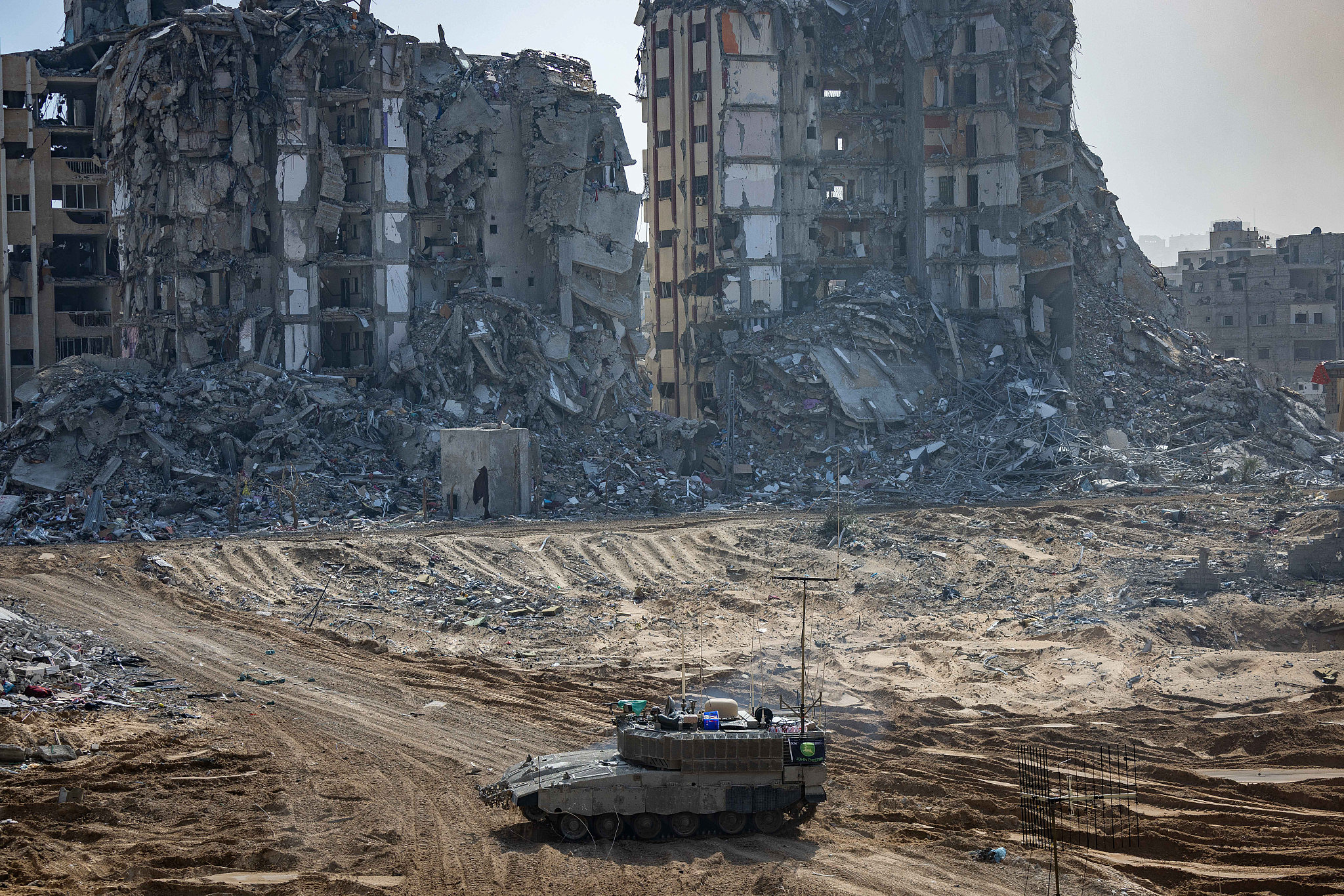
Yet these bombastic statements jar with the fact that Gaza, at least on the surface, appears as little more than a tiny speck on the globe. How has such a small piece of territory — comprising less than 1.5 percent of historic Palestine, and smaller than most U.S. cities — become the focal point of a major national, regional, and global struggle?
To anyone familiar with the history of the Gaza Strip, this state of affairs is hardly surprising. In fact, over the last 75 years, Gaza has continually been at the epicenter of Palestinian-Israeli history. All the major themes of the Palestinian struggle — dispossession, occupation, uprising, autonomy, and militancy — are encapsulated in this coastal enclave. Tracing the Strip’s history through these milestones can therefore illuminate the present moment and help explain the background to the current crisis.
Dispossession and exile
Originally a port city on the eastern Mediterranean, Gaza has a long history as a trading hub with key strategic positioning for the Middle East, North Africa, and southern Europe. But the 25-mile-long “Strip” that we know today is a direct outcome of the Nakba.
Under the 1947 UN Partition Plan, 55 percent of Palestine had been designated for a new Jewish state; the remaining 45 percent included Gaza City and a significant stretch of southwestern Palestine that extended into the Naqab/Negev desert. In reality, of course, Palestine faced a very different fate. In May 1948, after months of violence and expulsions, Jewish Agency leader David Ben-Gurion declared the establishment of the State of Israel, without specifying its borders. By the following year, Israeli forces had captured 78 percent of Palestine.
The events of the Nakba produced the modern-day Strip in both territorial and demographic terms. Egypt, which had joined other Arab states in declaring war on Israel in 1948, signed an armistice agreement with its new northern neighbor in February 1949. The armistice established the Gaza Strip with its current borders — a significantly smaller stretch of land than that designated by the UN in 1947 — under Egyptian administration.
At the same time, the creation of the Israeli state forcibly expelled and displaced at least three quarters of the Palestinian population, creating 750,000 Palestinian refugees. While this exodus transformed the demographics of the entire Levant, nowhere received more refugees per head than the Gaza Strip. Home to around 80,000 residents prior to the Nakba, by the end of the 1940s it had absorbed more than 200,000 refugees, tripling the area’s population. The Strip’s dense population in the 21st century, two-thirds of whom descend from those first refugees, can be traced directly to the impact of the Nakba.
For the hundreds of thousands of Palestinians living in Gaza in this period, life was characterized by widespread hardship and impoverishment. Both refugees and local Gazans had lost their farmlands and property to the new Israeli state, and all were cut off from the wider Palestinian economy with which they had previously interacted.
The eight refugee camps newly established to shelter thousands across the Strip were often overcrowded, unsanitary, and extremely uncomfortable. And while international humanitarian responses tended to focus on the refugees, many original Gazans themselves were just as impoverished; some had even been displaced, albeit within the Strip itself.
This early history of the Gaza Strip encapsulated Palestinian agency as well as dispossession. Amid the Nakba in 1948, Gaza hosted the Palestine National Council, which proclaimed the formation of the All-Palestine Government — the brainchild of exiled nationalist leaders and the first attempt to forge a Palestinian government-in-exile, albeit under Egyptian protection. In many ways it was the last gasp of Palestine’s old elites, who increasingly passed into irrelevance after the 1948 war.
Perseverance and agency
Determined to return to their lost homes and villages, many Palestinian refugees snuck across the border in the ensuing years to reunite with loved ones, retrieve belongings, tend to their crops, or simply look at their old homes. As exile continued, Palestinian fedayeen (militants) also increasingly crossed the border to undertake ambush operations against Israel.
As Israel did not distinguish between the various types of crossing, anyone entering from Gaza, or any Arab territory, was deemed an “infiltrator” and immediately shot at, deported, or killed if caught. It is estimated that anywhere from 2,700 to 5,000 Palestinians lost their lives in this way in the years after the Nakba.
At the same time, there were also signs of perseverance and even cultural flourishing in Gaza after the Nakba. In 1953, for example, it hosted an exhibit by the painter and art historian Ismail Shammut (who was born in Lydd and expelled to Khan Younis refugee camp in 1948), later described as Palestine’s first contemporary art exhibition.
Gaza also produced several leading poets in this period, including Mu’in Bseiso, Harun Hashim Rashid, and May Sayegh. All three fused cultural, social, and political themes in their works, reflecting the inescapably politicized nature of life in Gaza. Bseiso and Sayegh were also both outspoken activists in organized politics, the former as a communist and the latter as leader of the women’s division of the Ba’ath Party.
All the while, Gaza increasingly became a hub for fedayeen activity. Belonging to a younger generation than the figures behind the All-Palestine Government, the fedayeen tended to come from poorer backgrounds; many lived in refugee camps and were motivated by their direct experiences of displacement and dispossession.
Khalil al-Wazir, a prominent leader who organized fedayeen operations at this time, exemplified this archetype. Al-Wazir had been expelled from his hometown of Ramla in 1948 and then lived in Bureij camp. In the mid-1950s, he met a civil engineer visiting from Egypt named Yasser Arafat, and the two of them connected over their shared commitment to the Palestinian struggle. Joining forces with Salah Khalaf, another Gaza refugee from 1948, they would go on to found Fatah, the party that dominated Palestinian politics for the rest of the 20th century.
Despite its severance from the rest of Palestine, though, Gaza remained closely intertwined with the rest of the world in the 1950s and early 1960s. It was integrated into the Global South’s anti-colonial solidarity politics, especially after Gamal Abdel Nasser took the Egyptian Presidency in 1954, regularly citing the Palestinian cause as key to his pan-Arab leadership.
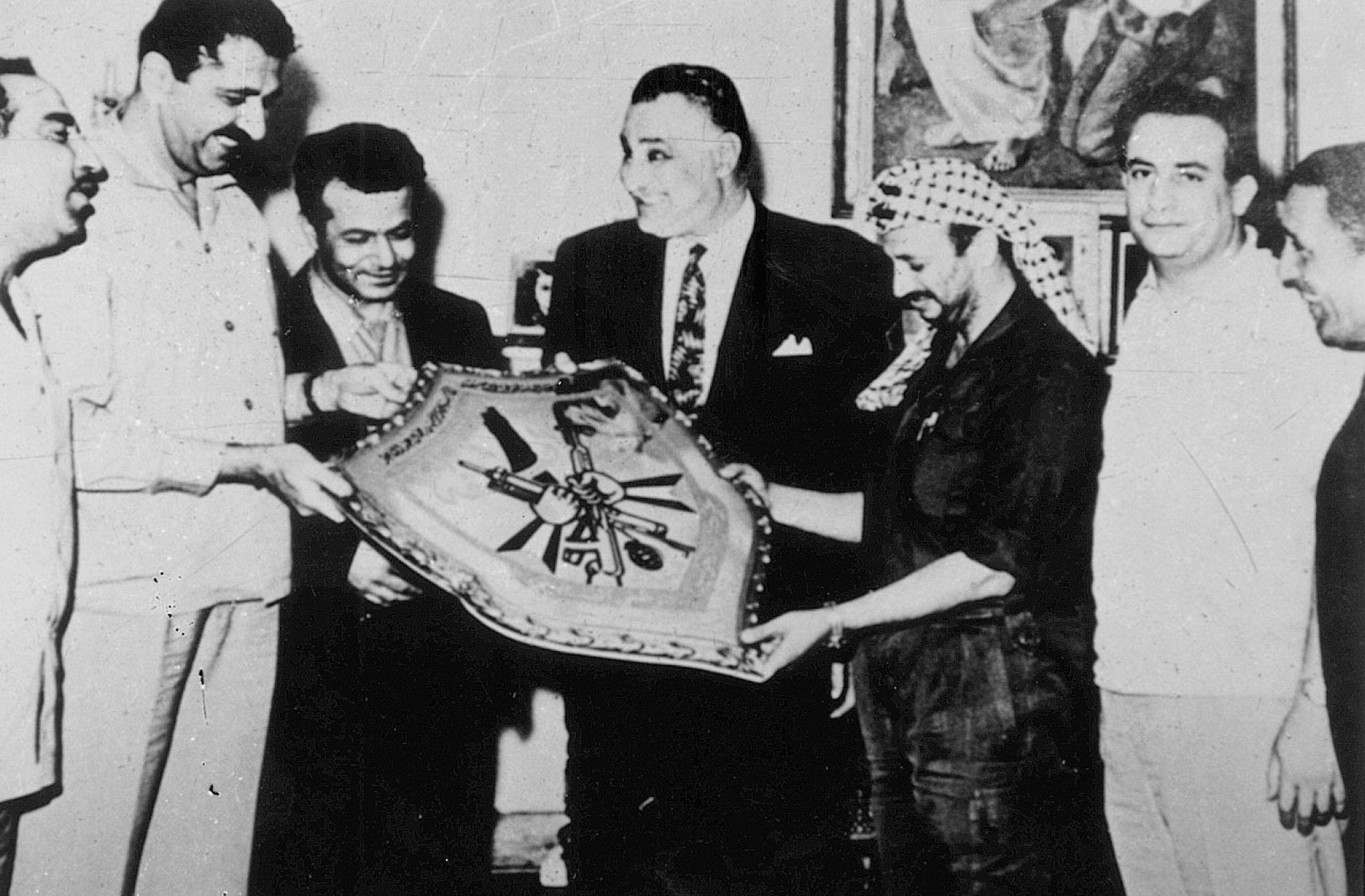
Accordingly, this period saw leading anti-colonial figures visit the Strip, including Che Guevera in 1959, Jawaharlal Nehru in 1960, and Malcolm X in 1964. All three of them visited refugee camps during their time there, highlighting the significance of the Palestinian refugees to the Strip’s politics and national aspirations.
Nonetheless, this period was not one of liberation for Palestinians. They were still living as a stateless people under Egyptian rule — first under a British-backed autocratic monarch until 1952, and then under the Free Officers’ regime that would come to be dominated by Nasser.
Egyptian military governors were still in charge of the Strip and, while Nasser vocally supported the Palestinian cause, he did not favor nationalist activism that might rival his own authority. Thus, although the people of Gaza were temporarily free from the Israeli regime that would blight their lives in years to come, their reality was far from the sovereign independent state they had struggled for in the run-up to 1948.
Occupation and settlements
While 1967 is usually cited as the starting point of the Israeli occupation, the Gaza Strip had already experienced an interlude of what was to come a decade earlier. In late October 1956, Israel invaded and occupied the Strip as part of its joint attack on Egypt with Britain and France, following Nasser’s nationalization of the Suez Canal Company. The Israeli army took over the Strip, coming face-to-face with many of the Palestinian refugees it had expelled just a few years earlier.
While that first Israeli occupation only lasted 4 months — ending at the command of U.S. President Dwight Eisenhower, who threatened to sanction Israel if it refused to withdraw — researchers have uncovered evidence of Israeli plans from that time for a longer-term presence in the Strip, and even the construction of Jewish settlements. When the Israeli army re-conquered Gaza a decade later, in June 1967, such plans were resumed, initiating the longest-running military occupation in modern history.
The new regime immediately had a seismic impact on the lives of Palestinians in Gaza. They were now subject to Israeli military law, with frequent searches, interrogations, and arrests. Israeli forces clamped down harshly on Palestinian nationalism — both armed and non-violent — with leading figures detained, deported, or disappeared. Many Palestinian activists were expelled or fled, with those who remained being regularly held in administrative detention without trial or charge. Israeli deportations continued into the 1970s, with more Palestinians from Gaza being forcibly expelled to the West Bank, Sinai, and Jordan.
While the occupation was enforced across both the West Bank and Gaza, from early on Israel’s policies diverged between the two. Israeli authorities saw the Strip as a particular source of concern, judging that its large refugee numbers, population density, and poverty made it more susceptible to radicalism.
As a result, Israeli leaders devised a series of policies in this period designed to thin out Gaza’s population, by breaking up its camps and instigating large-scale emigration. They pursued various strategies to achieve the latter, seeking to pay Gazans to start new lives in the Americas, or reduce the standard of living in the Strip to such an extent that people would be compelled to leave. Widespread refusal to cooperate among the refugees meant that Israel had limited success in these efforts.
At the same time, and somewhat ironically, the imposition of Israeli rule meant that Gaza and the West Bank — the two parts of Palestine not captured by Israel in 1948 — were now reunited under the same power. As a result, those in Gaza could reconnect with their relatives and friends in the West Bank, as well as those inside Israel, and vice versa. Crucially, the refugees could also visit their lost homes and towns for the first time since the Nakba, although many found that their houses had been destroyed, or that the Israelis now living there would not let them enter.
In contrast to the blockade and closures of the 21st century, Palestinians in Gaza had relatively freer movement in this period; the boundary separating Israel and Gaza was fairly porous, with both Palestinians and Israelis able to move across it quite easily. In fact, it became common for Palestinians to work inside Israel, with many becoming fluent in Hebrew as a result. Israelis, too, would visit Gaza for its cheap shopping, excellent car mechanics, and famous seafood.
However, the open movement at this time was far from an exchange of equals. Palestinian laborers working inside Israel were stateless non-citizens, meaning they had few rights and essentially served as a cheap labor pool. Gaza also provided a captive market for Israeli goods, strangulating the Strip’s own economic development. And, perhaps most significantly, the increasing overlap also entailed the establishment of illegal Israeli settlements across Gaza — eventually numbering 21 in total — displacing many Palestinians once again as their land was expropriated to make room for Jewish settlers, all under continued martial law.
Uprising and negotiations
Twenty years into the Israeli occupation, an entire Palestinian generation had grown up knowing nothing else. By the late 1980s, Israeli settlements were expanding and even prospering while Palestinians remained stateless and impoverished. Israel’s 1982 invasion of Lebanon and siege of Beirut, the Sabra and Shatila massacre that year, the failures of the Palestine Liberation Organization (PLO), and the rightward shift of Israeli politics following Likud’s rise to power in 1977, all added to Palestinian anger.
Experiencing the most acute forms of dispossession and military rule, Gaza became the birthplace to perhaps the most significant Palestinian uprising of the past century: the First Intifada.
The spark came in December 1987, when an Israeli army vehicle crashed into a Palestinian car in the Gaza Strip, killing four people; three of them lived in Jabalia camp, home to refugees who had been expelled from villages in southern Palestine during the Nakba. While Israeli authorities insisted the crash was accidental, many Palestinians were skeptical given the widespread experience of brutality and disinformation by the army.
The resulting uprising eventually spread across the entire Strip and to the West Bank. Largely taking the form of a mass civil disobedience campaign to force an end to the occupation, the First Intifada saw Palestinians refuse to pay Israeli-imposed taxes, boycott Israeli goods, and withdraw their labor from Israeli employers. It was also characterized, and symbolically immortalized, by young Palestinians throwing stones at Israeli soldiers, tanks, and other army vehicles. They were met with a brutal Israeli crackdown, most infamously after then-Defense Minister Yitzhak Rabin ordered the army to “break the bones” of the protestors.
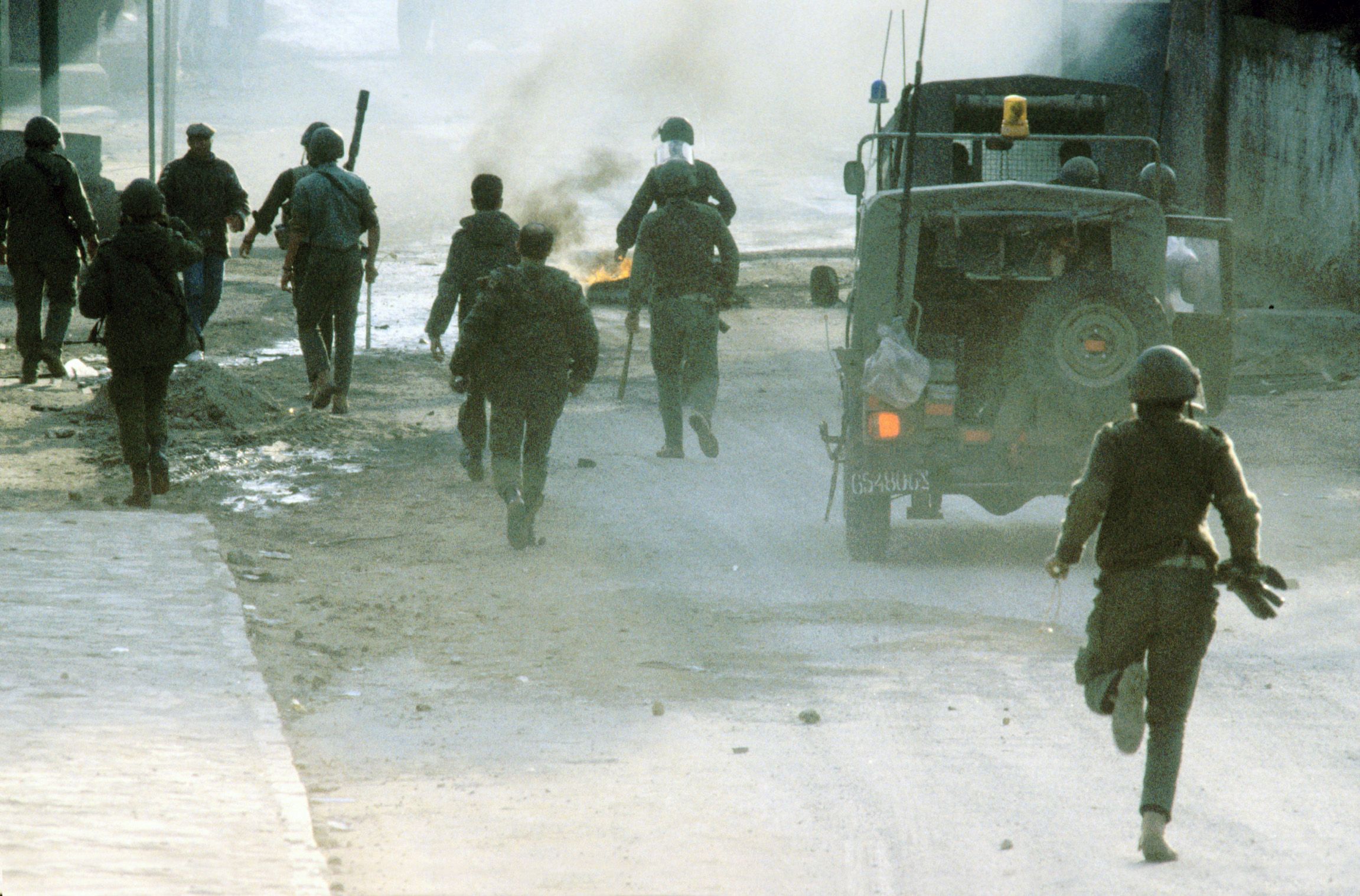
The First Intifada shocked many Israelis out of their belief that the occupation was sustainable or even benign. As such, it is credited as a pivotal factor in bringing about the first direct Israeli-Palestinian negotiations.
Nearly a year into the uprising, in November 1988, PLO chairman Yasser Arafat announced the organization’s decision to recognize Israel, renounce armed struggle, and agree to a two-state solution, with the future Palestinian state encompassing the Gaza Strip, the West Bank, and East Jerusalem as its capital. Three years later, the Madrid Peace Conference initiated tracks for diplomatic talks between the PLO and Israel with this vision in mind.
In September 1993, Rabin, by this stage Israel’s prime minister, shook hands with Arafat on the White House lawn as the two signed the Oslo Accords. Under the terms of Oslo, Israel would withdraw from parts of the West Bank and Gaza, paving the way for limited Palestinian self-government. In practice, Oslo amended the structures of the Israeli occupation without actually ending it, thus drawing criticism from some Palestinians that its terms simply accommodated their subjugation.
Once again, the Gaza Strip played a central role in the Oslo process. In a policy known as “Gaza First,” the Strip became a key focus of provisional Palestinian autonomy. In 1994, Arafat — who had been living in Tunisia since the PLO was expelled from Lebanon in 1982 — returned to Gaza, his father’s birthplace. From there he served as the first president of the newly-created Palestinian Authority (PA), a supposedly interim entity designed to last five years before “permanent status negotiations” and the creation of a fully independent Palestinian state.
Paradox and disillusionment
The Oslo years were a paradoxical time for Gaza. On the one hand, the period was characterized by hope that the new agreement would finally bring peace and prosperity. Gaza was feted internationally as a future “Singapore on the Mediterranean,” attracting investment and foreign aid; in 1998, Yasser Arafat International Airport was opened in Gaza. Some Gaza residents benefited from the resulting business and employment opportunities, as new hotels and restaurants sprung up across the Strip.
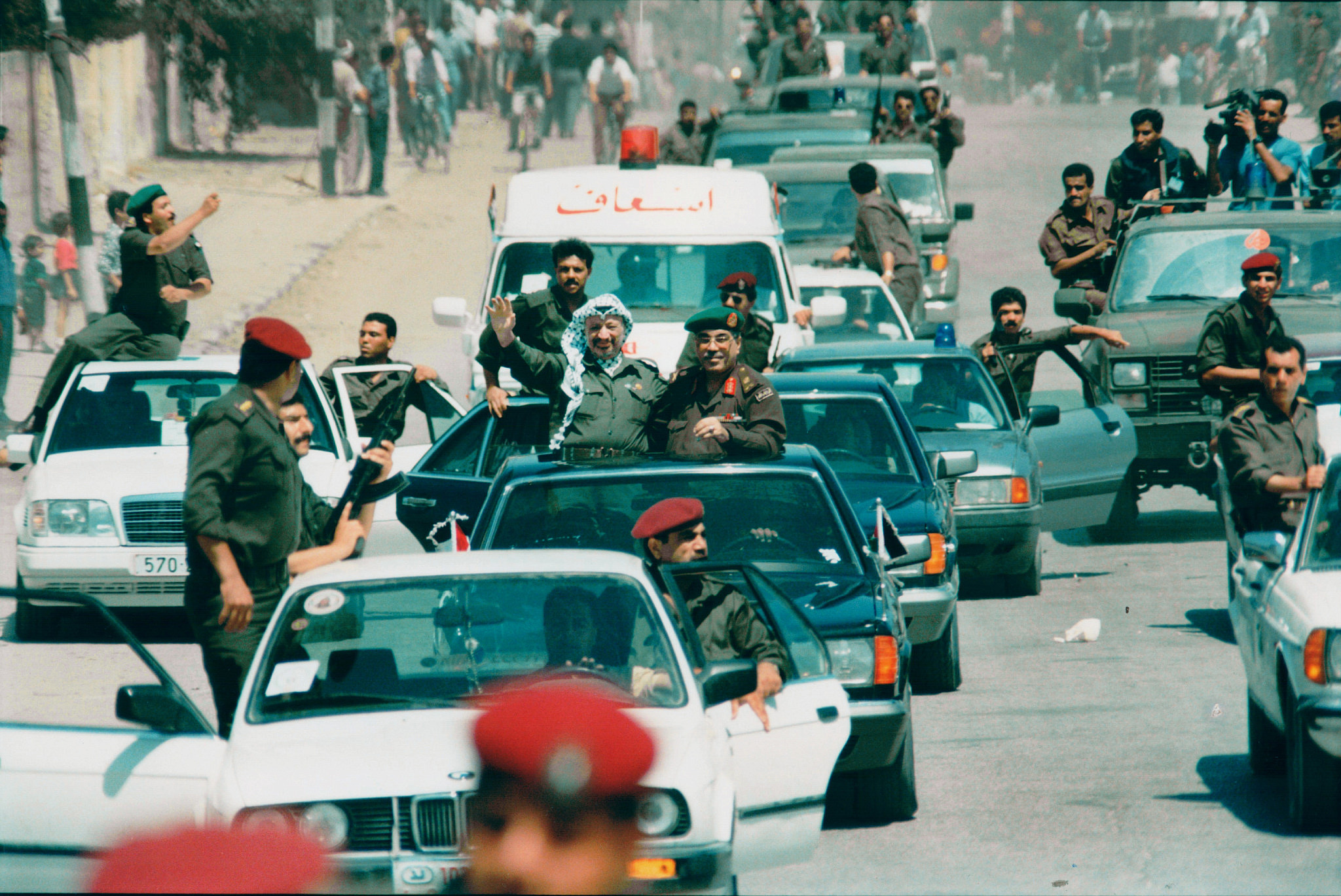
Yet for many others, the 1990s brought about worsening economic conditions. Following the First Intifada, Israel began instituting new measures to restrict Palestinian freedom of movement, including all-night curfews across the Strip from 1988. The curfews were lifted when the PA arrived in 1994, but otherwise, Oslo did little to reverse Israel’s increasingly draconian restrictions on Palestinian mobility.
The Israeli exit permit system, first introduced in 1991, remained in place, meaning that no Palestinian wishing to leave Gaza could do so without an army-issued permit (the same did not apply to Jewish settlers in Gaza, who continued to enjoy full freedom of movement). These permits became increasingly hard to obtain from 1998, making it more difficult for Palestinians to work inside Israel as many had done before.
The gradual severance of Gaza from the West Bank, through prohibitions on free movement between the two areas, also seriously limited intra-Palestinian trade and economic ties. Before 1993, 50 percent of goods produced in Gaza were marketed in the West Bank; by the end of 1996, it was down to 2 percent. The Paris Protocol, which dealt with the economic arrangements under Oslo, meant that Gaza remained a captive market for Israeli products, placing local businesses at a further disadvantage.
To make matters worse, the Oslo system quickly failed to live up to its political promises. After Rabin’s assassination by an Israeli extremist in 1995, Benjamin Netanyahu assumed the Israeli premiership for the first time and spoke openly of his aim of destroying the Oslo process. As the Israeli government continued to expand settlement-building across both the West Bank and Gaza, any possibility of viable Palestinian statehood became increasingly remote.
Meanwhile, the Israeli public became increasingly hostile to negotiations as Palestinian militias launched indiscriminate attacks on Israeli civilians over the 1990s. Belated attempts to advance permanent status negotiations at Camp David in 2000 were also insufficient, with Prime Minister Ehud Barak’s misleadingly named “Generous Offer” falling far below the PLO’s minimum demands for viable statehood.
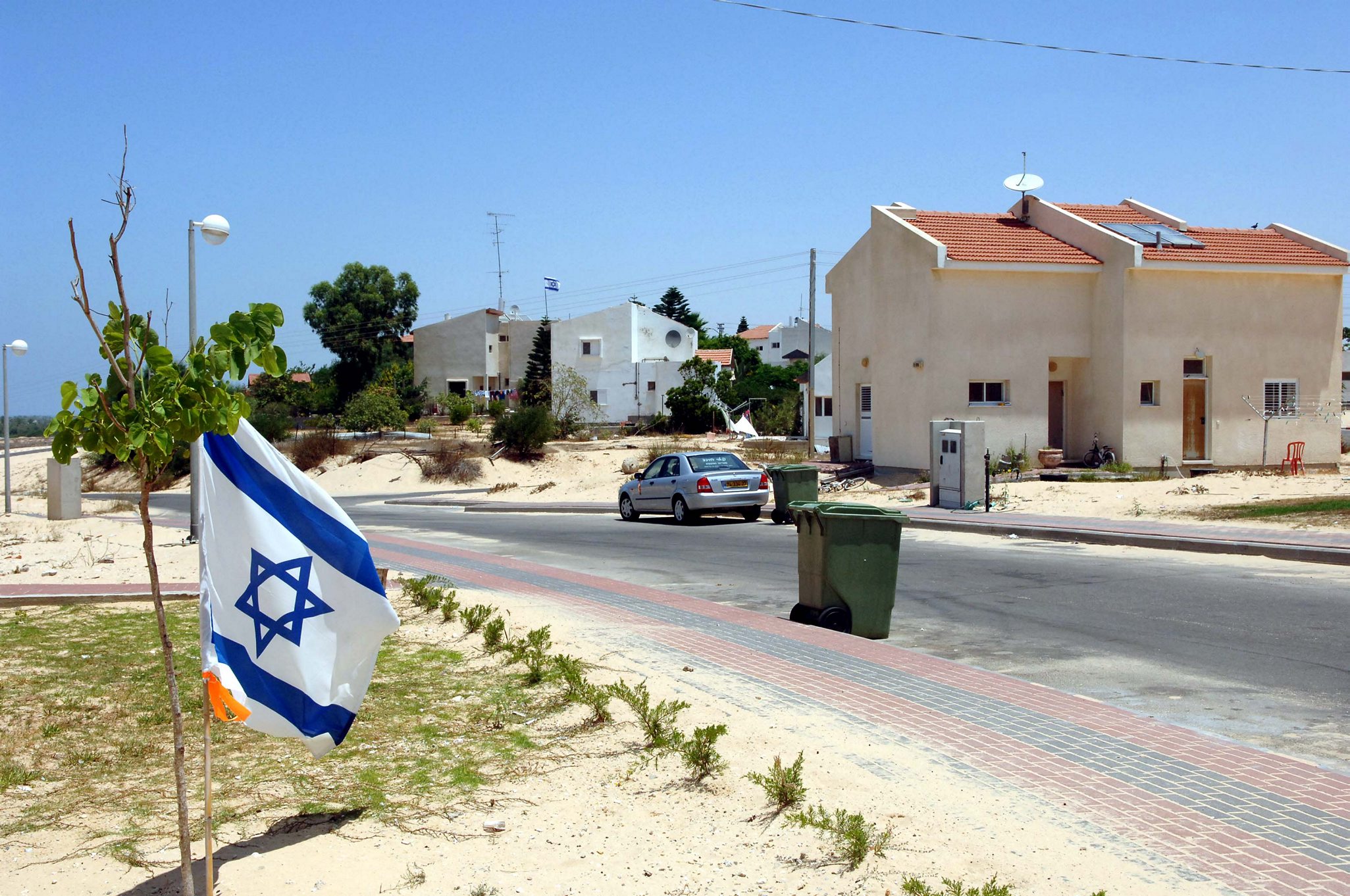
At the same time, the PA, dominated by Arafat’s Fatah party, became known by many Palestinians in the occupied territories for its corruption, authoritarianism, and collaboration with the Israeli state. Hostility grew as PA elites appeared to get richer while most ordinary Palestinians continued struggling to live under the occupation. Both Gaza and the West Bank saw increasing Palestinian hostility toward PA leaders, viewing them as ineffective, anti-democratic, and out-of-touch.
There was particular bitterness over the PA’s leading role in repressing activists and dissidents. Palestinians in Gaza had to get used to the presence of PA security forces, who were often working in collusion with the Israeli state. This rising disillusionment across both Gaza and the West Bank would feed into the Second Intifada, which broke out in Jerusalem in September 2000. The environment also provided ample territory for an alternative political force to emerge.
Militancy and siege
Islamism in general, and Hamas specifically, have a particular history in Gaza, stemming in part from the Strip’s proximity to the Muslim Brotherhood’s base in Egypt. Created as a Muslim Brotherhood offshoot at the start of the First Intifada, Hamas rejected the PLO’s push for negotiations with Israel and the ensuing Oslo Accords. It instead pursued a militant strategy against Israel, with indiscriminate attacks that killed Israeli civilians as well as soldiers.
Positioning itself as an authentic alternative to the elitist collaborator PA, Hamas highlighted the populist and rooted credentials of its leaders, many of whom lived in refugee camps in the occupied territories. The movement particularly gained prominence, and notoriety, for its use of suicide bombings in the 1990s and during the Second Intifada, which involved considerably more violence than the first.
In 2005, a year after Arafat’s death, Hamas claimed victory when Ariel Sharon’s government unilaterally dismantled Israel’s 21 settlements in the Strip and removed 9,000 Israeli settlers from the territory — while at the same time redirecting the state’s resources to further expanding the settlement project in the West Bank.
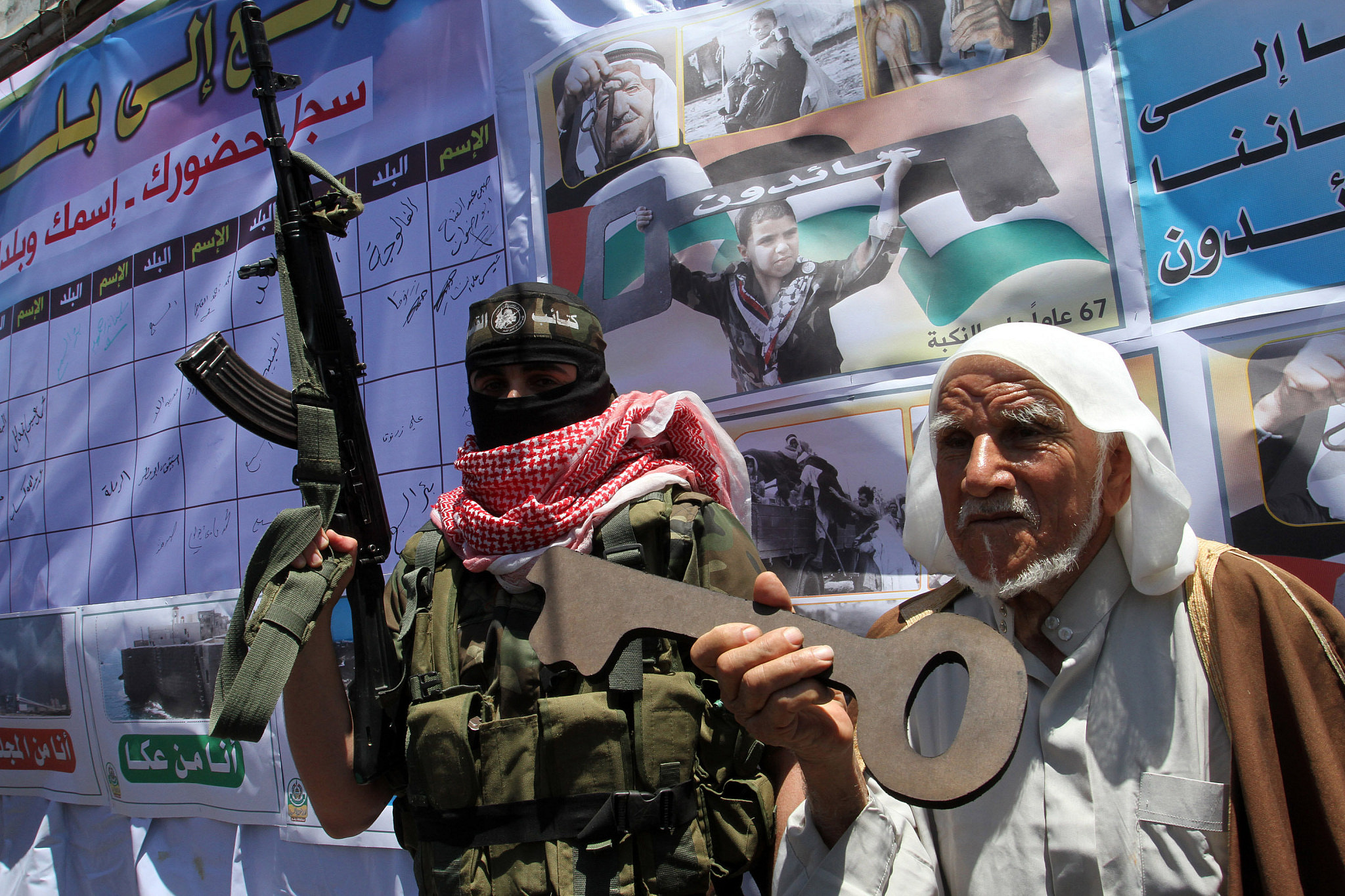
While the PA tried to cite the Gaza withdrawal as evidence of Oslo’s progress, the unilateral nature made this argument unconvincing. Moreover, while the move has often been described as a “disengagement,” in reality Israel retained full control of the Strip’s air, land, and sea borders. As a result, most legal scholars assert that Gaza has remained under Israeli occupation to this day.
Shortly afterward, Hamas announced its surprise decision to participate in Palestinian parliamentary elections, after a decade of boycotting them as part of its anti-Oslo stance. Running on a platform of anti-corruption against Fatah, Hamas’ Change and Reform party garnered 44 percent of the vote in the 2006 legislative election — a plurality and not a majority as is often implied. (It is important to note that Hamas did not win the election exclusively in Gaza; the elections were held across the West Bank and the Gaza Strip. Mahmoud Abbas, Arafat’s successor in the Fatah party, was separately elected for a four-year term as PA president in 2005.)
The Hamas-led government, however, was immediately met with sanctions by Israel and Western governments, led by the Bush administration. After weeks of clashes with Fatah, which attempted to regain power with U.S. backing, Hamas took control of the Gaza Strip by force. In response, Israel imposed a full blockade on the entire Strip, choking the economy with a move that the UN Secretary General deemed collective punishment. Egypt has largely supported the blockade, leaving more than 2 million Palestinians trapped in a tiny and overcrowded stretch of land.
Since 2007, Gaza’s history has been characterized by continuous violence. Frequent Israeli airstrikes were amplified by particularly intensive bombing campaigns in 2008-9, 2012, 2014, and 2021. There was further violence along the Gaza-Israel “border” in 2018-19, when Israeli snipers opened fire at the thousands of Palestinians who marched to the fence enclosing the Strip during the weekly Great March of Return, demanding an end to the blockade and the implementation of the refugees’ right to return.
Most read on +972
As Hamas and other Gaza-based militias have continued to launch indiscriminate rocket attacks against Israeli civilians, in violation of international law, Israel has justified its brutal wars as necessary defense measures. But the military campaigns have consistently deployed disproportionate force, and have been condemned by international observers as war crimes — particularly during the 2014 war, which is currently being investigated by the International Criminal Court.
Now, with the death count crossing 21,000 since October 7, Israel’s current military offensive on Gaza has already killed more Palestinians and destroyed more of the Strip’s infrastructure than the combined total of all previous attacks since 2007. And unfortunately, the toll looks set to keep rising significantly. With large parts of the Strip rendered uninhabitable, and threats of another mass expulsion looming, Gaza’s outsized significance in Palestinian and Israeli politics continues — and its people are the ones paying the price.

